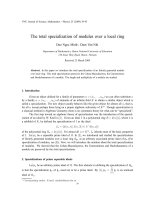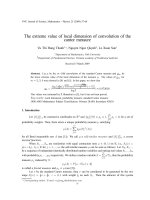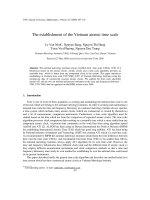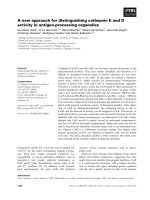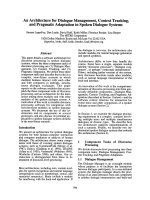Báo cáo " The dependence of the parametric transformation coefficient of acoustic and optical phonons in doped superlattices on concentration of impurities" pot
Bạn đang xem bản rút gọn của tài liệu. Xem và tải ngay bản đầy đủ của tài liệu tại đây (78.93 KB, 6 trang )
VNU Journal of Science, Mathematics - Physics 25 (2009) 123-128
123
The dependence of the parametric transformation coefficient
of acoustic and optical phonons in doped superlattices on
concentration of impurities
Hoang Dinh Trien*, Nguyen Vu Nhan, Do Manh Hung, Nguyen Quang Bau
Faculty of Physics, College of Science, VNU
334 Nguyen Trai, Thanh Xuan, Hanoi, Vietnam
Received 30 July 2008; received in revised form 15 August 2009
Abstract. The parametric transformation of acoustic and optical phonons in doped superlattices is
theoretically studied by using a set of quantum kinetic equations for the phonons. The analytic
expression of parametric transformation coefficient of acoustic and optical phonons in doped
superlattices is obtained, that depends non-linear on the concentration of impurities. Numerical
computations of theoretical results and graph are performed for GaAs:Si/GaAs:Be doped
superlattices.
Keywords: parametric transformation, doped superlattices.
1. Introduction
It is well known that in presence of an external electromagnetic field, an electron gas becomes
non-stationary. When the conditions of parametric resonance are satisfied, parametric resonance and
transformation (PRT) of same kinds of excitations such as phonon-phonon, plasmon-plasmon, or of
different kinds of excitations, such as plasmon-phonon will arise; i.e., the energy exchange process
between these excitations will occur [1-9]. The physical picture can be described as follows: due to the
electron-phonon interaction, propagation of an acoustic phonon with a frequency
q
ω
r
accompanied by
a density wave with the same frequency
Ω
. When an external electromagnetic field with frequency is
presented, a charge density waves (CDW) with a combination frequency
q
l
υ
±Ω
r
(l=1,2,3,4…) will
appear. If among the CDW there exits a certain wave having a frequency which coincides, or
approximately coincides, with the frequency of optical phonon,
q
υ
r
, optical phonons will appear.
These optical phonons cause a CDW with a combination frequency of
q
l
υ
±Ω
r
, and when
l
υω
±Ω≅
rr
, a certain CDW causes the acoustic phonons mentioned above. The PRT can speed up
the damping process for one excitation and the amplification process for another excitation. Recently,
there have been several studies on parametric excitation in quantum approximation. The parametric
______
*
Corresponding author. Tel.: 0913005279
Email:
H.D. Trien et al. / VNU Journal of Science, Mathematics - Physics 25 (2009) 123-128
124
interactions and transformation of acoustic and optical phonons has been considered in bulk
semiconductors [1-5], for low-dimensional semiconductors (doped superlattices, quantum wells,
quantum wires), the dependence of the parametric transformation coefficient of acoustic and optical
phonons on temperature T and frequency
Ω
is has been also studied [6-9]. In order to improve the
PRT theoretics for low-dimensional semiconductors, we, in the paper, examine dependence of the
parametric transformation coefficient of acoustic and optical phonons in doped superlattices on
concentration of impurities.
2. Model and quantum kinetic equation for phonons
We use model for doped superlattice with electron gas is confined by the superlattice potential
along the z direction and electrons are free on the xy plane. If a laser field
0
()=()
EtEsint
Ω
rr
irradiates
the sample in direction which is along the z axis, the electromagnetic field of laser wave will polarize
parallels the x axis and y axis, and its strength is expressed as a vector potential
()
At
r
=
c
Ω
0
()
Ecost
Ω
r
(c is the light velocity;
Ω
is EMW frequency;
0
E
is electric field intensity).
The Hamiltonian of the electron-acoustic phonon-optical phonon system in doped superlattice can
be written as (in this paper, we select
h
=1):
()=()
qqqqqq
Httaabbcc
ααα
α
εωυ
+++
+++
∑∑∑
rrrrrr
rr
''
,,
''
()()()()
qqqqqq
nnnn
CIqaabbDIqaacc
αααα
αααα
++++
−−
′′
+++
∑∑∑∑
rrrrrr
rr
rr
(1)
where
()
t
α
ε =
(())
n
e
kAt
c
ε
⊥
+
r
r
is energy spectrum of an electron in external electromagnetic field,
a
α
+
,
()
a
α
is the creation (annihilation) operator of an electron for state
|,
nk
⊥
〉
r
,
q
b
+
r
,
q
b
r
(
q
c
+
r
,
q
c
r
) is the
creation operator and annihilation operator of an acoustic (optical) phonon for state have wave vector
q
r
.
The electron-acoustic and optical phonon interaction coefficients take the forms[10]
2
2
22
2
0
11
||=;||=()
22
q
s
e
q
CD
VVq
ν
ξ
ρνχχχ
∞
−
r
rr
(2)
here V,
ρ
,
s
ν
, and
ξ
are the volume, the density, the acoustic velocity and the deformation potential
constant, respectively.
χ
is the electronic constant,
χ
∞
,
0
χ
are the static and high-frequency
dielectric constants, respectively. The electron form factor,
'
()
nn
Iq
r
is written as [11]:
0
''
=1
0
()=()()
s
d
iqd
n
nnn
j
Iqezjdzjddz
′
Φ−Φ−
∑
∫
r
(3)
here,
()
n
z
Φ is the eigenfunction for a single potential well, and
0
s
is the number of doped
superlattices periods,
d
is the period.
Energy spectrum of electron in doped superlattic [12]:
1
22
2
4
1
()=;=()()
22
D
nnn
ken
kn
mm
π
εεε
χ
⊥
⊥
++
r
r
(4)
H.D. Trien et al. / VNU Journal of Science, Mathematics - Physics 25 (2009) 123-128
125
here,
D
n
is concentration of impurities,
m
and
e
are the effective mass and the charge of the electron,
respectively and
n
e
are the energy levels of an individual well.
In order to establish a set of quantum kinetic equations for acoustic and optical phonons, we use
equation of motion of statistical average value for phonons
<>=[,()];<>=[,()]
qtqtqtqt
ibbHticcHt
tt
∂∂
〈〉〈〉
∂∂
rrrr
(5)
where
t
X
〈〉
means the usual thermodynamic average of operator X.
Using Hamiltonian in Eq.(1) and realizing operator algebraic calculations, we obtain a set of
coupled quantum kinetic equations for phonons. The equation for the acoustic phonons can be
formulated as:
'
'
=()()[()()]
qtqqtn
n
nnk
bibJJfkqfk
t
νµ
λλ
ω
∞
⊥⊥
−∞
⊥
∂
〈〉+〈〉−−−×
∂ΩΩ
∑∑
rrr
r
rr
r
22
1''
{||()()}
t
qqtqtqqqtqt
nnnn
dtCIbbCDIcc
++
−−−
−∞
×〈〉+〈〉+〈〉+〈〉×
∫
rrrrrrr
'11
{[()()]()}
n
n
expikkqttitit
εενµ
⊥⊥
×−−−−Ω+Ω
rr
r
(6)
A similar equation for the optical phonons can be obtained in which
qt
c
〈〉
r
,
qt
b
〈〉
r
,
q
υ
r
,
q
ω
r
,
q
C
r
,
q
D
r
are replaced by
qt
b
〈〉
r
,
qt
c
〈〉
r
,
q
ω
r
,
q
υ
r
,
q
D
r
,
q
C
r
, respectively.
In Eq.(6),
()
n
fk
⊥
r
is the distribution function of electrons in the state
|,
nk
⊥
〉
r
,
()
J
µ
λ
Ω
is the
Bessel function, and
0
=
eEq
m
λ
Ω
r
r
3. The parametric transformation coefficient of acoustic and optical phonon in doped
superlattices
In order to establish the parametric transformation coefficient of acoustic and optical phonon, we
use standard Fourier transform techniques for statistical average value of phonon operators:
qt
b
〈〉
r
,
qt
b
+
−
〈〉
r
,
qt
c
〈〉
r
,
qt
c
+
−
〈〉
r
. The Fourier transforms take the form :
1
()=;=()
2
itit
qqtqtq
edted
ωω
ωωω
π
∞∞
−
−∞−∞
Ψ〈Ψ〉〈Ψ〉Ψ
∫∫
rrrr
(7)
One finds that the final result consists of coupled equations for the Fourier transformations
()
q
C
ω
r
and
()
q
B
ω
r
of
qt
c
〈〉
r
and
qt
b
〈〉
r
.
For instance, the equation for
()
q
C
ω
r
can be written as:
22
'
'
=
()
()()=2||(,)
q
qqqql
nn
l
q
nn
Cl
CIDPq
l
ω
ωυωυω
ωυ
∞
−∞
−Ω
−+
−Ω+
∑∑
r
rrrr
r
r
H.D. Trien et al. / VNU Journal of Science, Mathematics - Physics 25 (2009) 123-128
126
2
'
'
=
()
2||(,)
q
qqql
nn
l
q
nn
Bl
IDCPq
l
ω
ωω
ωω
∞
−
−∞
−Ω
+
−Ω+
∑∑
r
rrr
r
r
(8)
In the similar equation for
()
q
B
ω
r
, functions such as
()
q
C
ω
r
,
()
q
Cl
ω
−Ω
r
,
()
q
Bl
ω
−Ω
r
,
q
υ
r
,
q
ω
r
,
q
C
r
,
q
D
r
are replaced by
()
q
B
ω
r
,
()
q
Bl
ω
−Ω
r
,
()
q
Cl
ω
−Ω
r
,
q
ω
r
,
q
υ
r
,
q
D
r
,
q
C
r
, respectively.
In Eq.(8), we have:
=
(,)=()()()
llq
PqJJ
µµ
µ
λλ
ωωµ
∞
+
−∞
Γ+Ω
ΩΩ
∑
r
r
(9)
'
'
[()()]
()=
()()()
n
n
q
k
n
n
fkfkq
kki
ωµ
εεωµδ
⊥⊥
⊥⊥
⊥
−−
Γ+Ω
−−+Ω−
∑
r
r
rr
r
rr (10)
where, the quantity
δ
is infinitesimal and appears due to the assumption of an adiabatic interaction of
the electromagnetic wave (EMW).
In Eq.(8), the first term on the right-hand side is significant just in case l=0. If not, it will
contribute more than second order of electron-phonon interaction constant. Therefore, we have
22
'
'
()
()()=2||||(,)
q
qqqql
nn
q
nn
Cl
CIDPq
l
ω
ωυωυω
ωυ
−Ω
−
−Ω+
∑
r
rrrr
r
r
2
'
'
=
()
2||(,)
q
qqql
nn
l
q
nn
Bl
IDCPq
l
ω
ωω
ωω
∞
−∞
−Ω
+
−Ω+
∑∑
r
rrr
r
r
(11)
Transforming Eq.(11) and using the parametric resonant condition
m
ωυ
+Ω≅
rr
, the parametric
transformation coefficient is obtained
2
'
'
22
'0
'
||(,)
()
==
()||||(,)
qql
nn
nn
l
qqqq
nn
nn
IDCPq
C
K
BiIDImPq
ω
υ
ωδυ
−−
−
∑
∑
rr
rr
rrrr
r
r
(12)
Consider the case of
=1
l
; and assign
22
'
0'0
=||||(,)
nn
nn
IDImPq
γυ
∑
rr
r
Note that
0
=
δγ
, we have
2
'1
'
1
0
||(,)
=
nn
nn
IDCPq
K
i
ω
γ
−−
∑
rr
r
(13)
Using Bessel function, Fermi-Dirac distribution function for electron and energy spectrum of electron
in Eq.(4), we have
1
0
=||
2
K
γ
Γ
(14)
Where
2
'
'
=||()
qqqq
nn
nn
IDCRe
λ
ω
ΓΓ
Ω
∑
rrrr
(15)
22
0'
'
=||||()
qqq
nn
nn
IDIm
γυ
Γ
∑
rrr
(16)
H.D. Trien et al. / VNU Journal of Science, Mathematics - Physics 25 (2009) 123-128
127
2
1/2
0
1
4
()=[[()(1/2)]
2
D
fm
en
Reexpn
Am
π
ωβ
πβχ
Γ−+
rr
2
1/2'
4
[()(1/2)]]
D
en
expn
m
π
β
χ
−−+
(17)
22
1/2
0
2
2
42
()=()[()(1/2)]
22
D
fm
mAenm
Imexpexpn
qqm
ππ
υββ
πβχ
Γ−−+
rr
rr
()()
22
expsinh
βυβυ
×
rr
(18)
2
2
1/2'
1
4
=()()
2
D
q
enq
Ann
mm
π
ω
χ
+−+
r
r
;
2
2
1/2'
2
4
=()()
2
D
q
enq
Ann
mm
π
υ
χ
+−+
r
r
(19)
In Eqs.(17) and (18),
=1/
b
kT
β (
b
k
is Boltzmann constant),
0
f
is the electron density in doped
superlattices.
1
K
is analytic expression of parametric transformation coefficient of acoustic and optical phonon
in doped superlattices when the parametric resonant condition
l
ωυ
±Ω≅
rr
is satisfied
4. Numerical results and discussions
In order to clarify the mechanism for parametric transformation coefficient of acoustic and optical
phonons in doped superlattices, in this section we perform numerical computations and graph for
GaAs:Si/GaAs:Be doped superlattices. The parameters used in the calculation [6,7]
=13.5
eV
ξ
,
3
=5.32
gcm
ρ
−
,
1
=5378
s
ms
ν
−
,
=10.9
χ
∞
,
0
=12.9
χ ,
=10
dnm
,
0
=0.066
mm
,
0
m
being the mass
of free electron,
0
=36.25
meV
ωh ,
6
0
=10/
EVm
(
0
E
is electric field intensity),
23
=1.380710/
b
kjK
−
×
,
233
0
=10
fm
−
,
19
=1.6021910
eC
−
×
,
34
=1.0545910.
js
−
×h , T=300K,
71
=3.210
qm
−
× .
Fig. 1. Dependence of the
1
K
on
D
n
.
Fig 1 shows the parametric transformation coefficient K1 as a function of concentration of
impurities
D
n
. It is seen that the parametric transformation coefficient of acoustic and optical phonons
in doped superlattices depends non-linearly on concentration of impurities
D
n
. Especially, when
concentration of impurities
D
n
tend toward zero, value of the parametric transformation coefficient of
acoustic and optical phonons in doped superlattices will turn back nearly equal that in bulk
H.D. Trien et al. / VNU Journal of Science, Mathematics - Physics 25 (2009) 123-128
128
semiconductors [5] (
1
0.35
;
K
), when concentration of impurities raises, the parametric
transformation coefficient also to increase. This can be explained as follows: when concentration of
impurities
D
n
tend toward zero, the doped superlattices as a normal bulk semi- conductors. When
concentration of impurities raises large enough, the doped superlattices is as low-dimensional
semiconductor.
5. Conclusions
In this paper, we obtain analytic expression of the parametric transformation coefficient of
acoustic and optical phonons in doped superlattices in presence of an external electromagnetic field
1
K
, Eqs.(14)-(19). It is seen that
1
K
depends on concentration of impurities. Numerical computations
and graph are performed for GaAs:Si/GaAs:Be doped superlattices, fig 1. The results is seen non-
linear dependence of parametric transformation coefficient on concentration of impurities. when
concentration of impurities
D
n
tend toward zero, value of the parametric transformation coefficient of
acoustic and optical phonons in doped superlattices will turn back nearly equal that in bulk
semiconductors [5] (
1
0.35
;
K ), when concentration of impurities raises, the parametric
transformation coefficient also to increase. This can be explained as follows: when concentration of
impurities
D
n
tend toward zero, the doped superlattice as a normal bulk semiconductors. When
concentration of impurities raises large enough, the doped superlattice is a low-dimensional
semiconductor.
Acknowledgments. This work is completed with financial support from NAFOSTED and QG.09.02
References
[1] G.M. Shmelev, N.Q. Bau, Physical phenomena in simiconductors, Kishinev, 1981.
[2] V.P. Silin, Parametric Action of the High-Power Radiation on Plasma (National Press on Physics Theory).
Literature, Moscow, 1973.
[3] M.V. Vyazovskii, V.A. Yakovlev, Sov. Phys. Semicond. 11 (1977) 809.
[4] E.M. Epshtein, Sov. Phys. Semicond. 10 (1976) 1164.
[5] G.M. Shmelev, N.Q. Bau, V.H. Anh, Communiccation of the Joint Institute for Nuclear, Dubna, 600 (1981)
17.
[6] L.V. Tung, T.C. Phong, P.T. Vinh, N.Q. Bau, J. Science (VNU), 20 (No3AP) (2004) 146.
[7] N.Q. Bau, T.C. Phong, J.Kor. Phys. Soc. 42 (2003) 647.
[8] N.V. Diep, N.T. Huong, N.Q. Bau, J.Scienc (VNU), 20 (No3AP) (2004) 41.
[9] T.C. Phong, L. Dinh, N.Q. Bau, D.Q. Vuong, J. Kor. Phys. Soc. 49 (2006) 2367.
[10] N. Mori, T.Ando. Phys. Rev. B 40, (1989) 12.
[11] V.V. Pavlovic, E.M. Epstein, Sol. Stat. Phys. 19 (1977) 1760.
[12] T.C. Phong, L.V. Tung, N.Q. Bau, Comm.in phys, Supplement (2004) 70.

